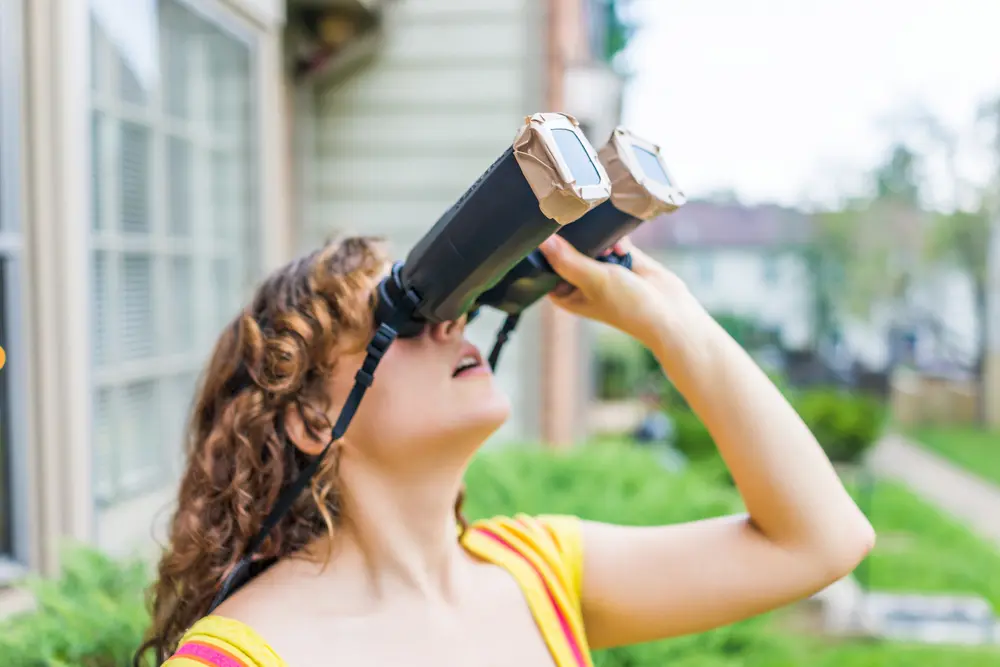Don’t Look Directly at It! Safe Ways to View a Solar Eclipse
The awe-inspiring spectacle of a solar eclipse, when the moon blocks the sun’s light, has captivated humanity for centuries. But witnessing this celestial dance requires caution – looking directly at the sun, even during an eclipse, can permanently damage your eyes.
This guide explores safe ways to experience a solar eclipse, ensuring you don’t miss out on this natural wonder while protecting your precious vision.
1. Certified Eclipse Glasses
The safest way to view a solar eclipse directly is with certified eclipse glasses. These specialized glasses feature filters that dramatically reduce the sun’s intensity, allowing you to see the eclipse without harming your eyes. Here’s what to look for:
- ISO Certification: Ensure the glasses meet the International Organization for Standardization (ISO) 12312-2 safety standard. This guarantees they provide sufficient filtration for safe solar viewing.
- Look and Feel: Certified glasses should be a dark shade, typically orange or reddish-orange, and completely block out any light leakage around the edges.
- Purchase from Reputable Sources: Buy your eclipse glasses from reputable astronomy stores, science centers, or eclipse-related websites. Avoid unreliable vendors or street sellers.
Important Reminders:
- Never reuse old eclipse glasses. Filters can degrade over time, rendering them unsafe.
- Never look through a telescope or binoculars without a proper solar filter. These instruments concentrate sunlight, posing a significant risk to your eyes.
- Don’t rely on sunglasses, even very dark ones. Regular sunglasses do not provide adequate filtration for safe eclipse viewing.
2. Indirect Viewing Methods
If you can’t find certified eclipse glasses or prefer an alternative method, there are safe ways to indirectly experience the eclipse:
- Pinhole Projector: This simple DIY method creates a projected image of the eclipse on a surface. Take two pieces of cardboard, one with a small pinhole punched in the center. Face the pinhole towards the sun and hold the second cardboard a short distance behind it. The sunlight passing through the pinhole will project a small image of the eclipsed sun onto the second piece of cardboard.
- Solar Eclipse Viewers: These pre-made viewers often resemble binoculars but contain special filters that project a safe image of the eclipse onto an internal screen.
- Livestreams and Broadcasts: Many organizations, including NASA, often host online streams and live broadcasts of solar eclipses. These offer a safe and convenient way to witness the event from the comfort of your home.
Sharing the Experience:
Solar eclipses are a great opportunity to share the wonder of science with others. Here are some ideas:
- Organize a watch party: Gather friends and family and use safe viewing methods to experience the eclipse together.
- Visit a local astronomy club or museum: Many organizations host eclipse viewing events with proper equipment and expert guidance.
- Educate children: Teach children about the science behind solar eclipses and the importance of safe viewing practices.
Frequently Asked Questions: Safe Solar Eclipse Viewing
Q: Can I reuse eclipse glasses from a previous eclipse?
A: It’s generally not recommended. Filters can degrade over time, so it’s best to use new, certified glasses for every eclipse.
Q: Is it safe to look at the eclipse during totality, the phase where the sun is completely covered?
A: Totality is a brief period, typically lasting only a few minutes. While it’s generally considered the safest time to glance at the eclipse without filters, exercising caution is still advisable. Some residual sunlight can still be emitted from the sun’s corona, so a quick look is recommended, followed by looking away immediately.
Q: Where can I find a livestream of a solar eclipse?
A: Many organizations offer livestreams. NASA (https://www.nasa.gov/) often hosts broadcasts, and websites like Slooh (https://www.slooh.com/) specialize in astronomy livestreams.
Beyond the Eclipse: Exploring the Fascinating World of Solar Astronomy
Gazing at a solar eclipse ignites a sense of wonder about our universe. But the sun is a captivating celestial object worthy of exploration beyond these rare events. This section dives into the exciting world of solar astronomy, the scientific study of our nearest star.
Unlocking the Sun’s Secrets:
Solar astronomers use sophisticated telescopes, satellites, and ground-based instruments to study the sun’s behavior. Their research delves into:
- Sunspots: These dark, cooler regions on the sun’s surface are linked to solar flares and coronal mass ejections (CMEs) – powerful bursts of energy that can impact Earth’s technology and climate.
- Solar Prominences: Erupting loops of plasma (charged particles) that can extend millions of kilometers from the sun’s surface. Understanding these features helps predict solar activity.
- The Sun’s Corona: The sun’s outer atmosphere, invisible to the naked eye but visible during a solar eclipse. Studying the corona’s temperature and composition is crucial for understanding solar wind, a stream of charged particles that can affect Earth’s magnetosphere.
The Impact on Earth:
The sun’s activity directly affects our planet. Solar flares and CMEs can disrupt power grids, communication systems, and GPS navigation. Understanding and predicting these events is crucial for mitigating their impact on our infrastructure.
The Quest for Renewable Energy:
Solar astronomy plays a role in developing renewable energy sources like solar power. By studying the sun’s activity, scientists can improve solar panel efficiency and develop better ways to store solar energy.
Exploring the Future:
The sun holds many mysteries. Solar astronomers are constantly seeking answers to questions like:
- Can we predict solar activity with greater accuracy?
- What is the long-term impact of solar activity on Earth’s climate?
- Are there other stars like our sun that could potentially support life?
Engaging with Solar Astronomy:
There are numerous ways to delve deeper into the fascinating world of solar astronomy:
- Citizen Science Projects: Participate in online projects that contribute to solar research, such as classifying sunspots or analyzing solar data.
- Visit a Solar Observatory: Many observatories offer public tours and events, allowing you to see the cutting-edge equipment used to study the sun.
- Online Resources: Websites like NASA’s Solar Dynamics Observatory (https://sdo.gsfc.nasa.gov/) provide real-time images and information about the sun’s activity.
Remember: Safety is paramount when viewing a solar eclipse. By following these guidelines and using safe viewing methods, you can ensure a memorable and eye-safe experience of this awe-inspiring celestial event.



